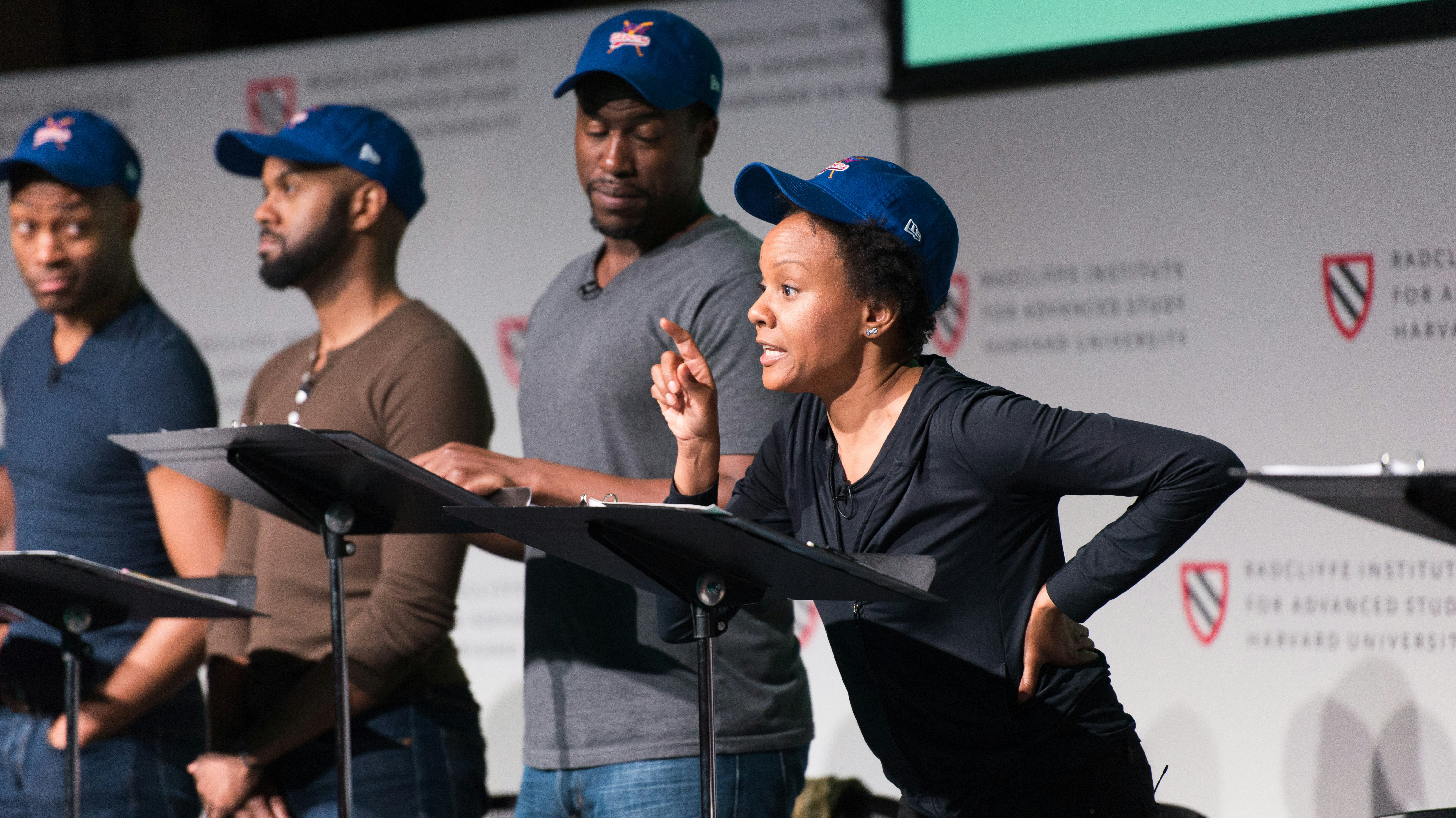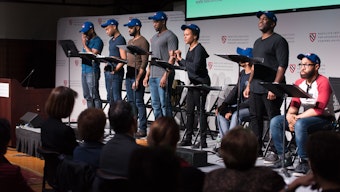Game Changers: Exploring Sports and Gender

Athletes, coaches, physicians, policymakers, and scholars examined—at the spring 2017 Radcliffe conference on gender—a range of contemporary issues using sports as a lens, from access and inclusion to health and medical research to media and popular culture.
In opening remarks at the Radcliffe Institute conference titled “Game Changers: Sports, Gender, and Society,” Dean Lizabeth Cohen drew spontaneous applause when she mentioned the 2017 world champion US women’s national hockey team’s other hard-fought, headline-worthy victory this year: the fight to gain unprecedented pay and benefit concessions in a new four-year contract with USA Hockey. “All it took,” deadpanned Cohen, “was the threat of a boycott, 15 months of tense negotiations, and an open letter from 16 US senators.”
Cohen’s introduction set the stage for Radcliffe’s annual conference on gender, which this year offered a dynamic exchange of ideas among athletes, coaches, physicians, policymakers, and scholars. Using sports as a lens, they examined a range of contemporary issues, from access and inclusion to health and medical research to media and popular culture.
Who Gets to Play?
Forty-five years ago, the landmark US legislation known as Title IX made it illegal for schools to discriminate on the basis of gender in any program or activity that receives federal funding. The law opened opportunities for women that would have been inconceivable to generations of past female athletes, observed the historian Susan Ware AM ’73, PhD ’78, moderator of a session that looked at the rights female athletes have won and the structural and societal barriers that still exclude many.
Donna Lopiano, former CEO of the Women’s Sports Foundation, noted that despite significant gains, female high school athletics in 2014 still had not achieved the participation rates that male student athletics enjoyed in 1971. “The story is similar in college,” she said, adding that the gender gap in many university sports programs has begun to widen over the past decade, in part owing to what Lopiano termed “the arms race” to fund revenue-producing men’s football and basketball programs. “Title IX does not require giving equal dollars to men’s and women’s sports,” she explained.
The need for more female leaders in sports—especially in the ranks of coaches, commissioners, administrators, and board members—was a common theme at the conference.
One young leader who is making her voice heard is the Paralympic gold medalist Stephanie Wheeler, who overcame the “double whammy” of gender- and ability-based barriers to become the head coach of women’s wheelchair basketball at the University of Illinois. “We need to redefine what bodies that can compete look like,” Wheeler stated, adding that while sports participation has become a “right” for able-bodied athletes, it is still widely viewed as a “privilege” for the disabled. “Old myths and perceptions create attitudinal barriers that are often more difficult to transcend than physical ones,” she observed.
Health and Wellness
Differences in how males and females experience and recover from sports injuries was a central concern voiced by Cheri Blauwet, a physician, researcher, assistant professor of physical medicine and rehabilitation at Harvard, and a Paralympic athlete who has twice won both the New York and the Boston marathons. “With over 3 million girls participating in sports in the post–Title IX era,” Blauwet observed, “how we address treatment and issues related to sports injury according to gender will be ever more important over time.”
The panelist Brian Hainline, chief medical officer of the National Collegiate Athletic Association, ran through a list of common sports injuries, including ACL tears and concussions, that affect women and men differently. More research is needed to understand these differences, Hainline said, noting that “95 percent of world literature on concussions is dominated by men’s football and men’s ice hockey.”
Beyond challenges posed by physical injuries, Hainline said, factors such as pressure from parents and coaches, body-image issues, and sexual assault have made “mental health issues the single most important malady we need to treat among young athletes of both genders today.” Pressure can come from many quarters. Travis Tygart, CEO of the US Anti-Doping Agency, said, “We talk to athletes all the time who believe they have to use dope to compete. Elite and developing athletes—some as young as 10—are being pressured to take supplements.”
Gender, Media, and Popular Culture
It’s no accident, said the University of Minnesota professor Mary Jo Kane, that media so often portray female athletes “off the court, out of uniform, and in highly sexualized poses.” Images celebrating the reality that women are powerful athletes threaten entrenched beliefs, Kane said.
Michael Messner, a sociologist at the University of Southern California, views women’s advances in sports and society over the past few decades “not as a revolution or stalled revolution,” he said, but, rather, as “social change that is incomplete.” Decisions that are being made today in print and electronic newsrooms and boardrooms will influence the future path of that change, said Messner. The encouraging news is that sports networks and marketers are increasingly aware that women athletes and fans are a growing market that is too big to ignore. The ESPN sports writer Kavitha Davidson shared research by her network showing that 50 percent of all sports fans today—115 million people—are women, and their numbers are rising more rapidly than men’s. “The Title IX generation accounts for this,” she said, noting that their daughters are following their example.
Lessons from the Ring
The keynote event of the “Game Changers” conference was a conversation with the four-time world champion middleweight boxer Laila Ali, a fitness and wellness expert, past president of the nonprofit Women’s Sports Foundation, and outspoken advocate for women in professional sports. “Today more than ever,” Ali told the Knafel Center audience, “women need to be inspired to find the greatness within themselves. We’re warriors, we’re champions, and we’re definitely athletes.”
Asked by the award-winning sports journalist Christine Brennan how Ali’s late father—the boxing legend Muhammad Ali—had influenced her career, Ali said he had initially resisted the idea that she, or any woman, should be in the ring. But she changed his mind when she started winning fights. “In fact,” Ali said, “after he got so sick with Parkinson’s, I often felt like I was fighting for both of us.”
Serving as a role model for strong women and girls is something Ali takes very seriously. “My message is to focus on being strong and healthy, rather than a certain size,” she stressed. “For instance, I have big hands. That’s bad for finding jewelry that fits, but it was great when I started knocking people out!”
Ali said the grueling hours she devoted to roadwork, sit-ups, footwork drills, and sparring in the ring taught her “how to dig deep.” Sports teaches women the confidence “to know you can keep going even when you get beat up,” she said. “That’s a lesson you can apply to everything else in your life.”
Deborah Blagg is a freelance writer.
The conference began with a staged reading from the play Toni Stone, by Lydia R. Diamond RI ’13, based on the book Curveball: The Remarkable Story of Toni Stone, the First Woman to Play Professional Baseball in the Negro League, by the historian Martha Ackmann RI ’09.








